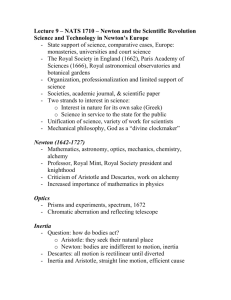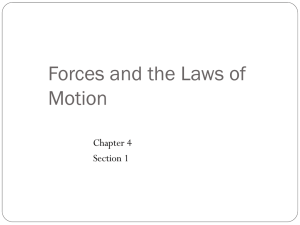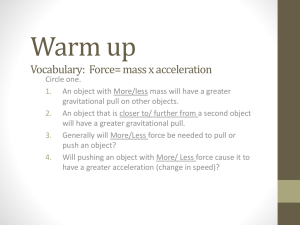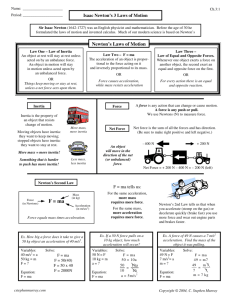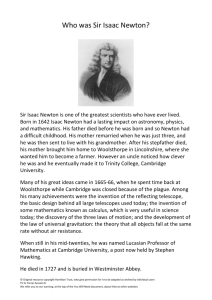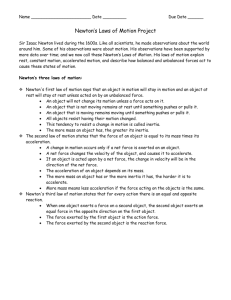Sir Isaac Newton handout
advertisement
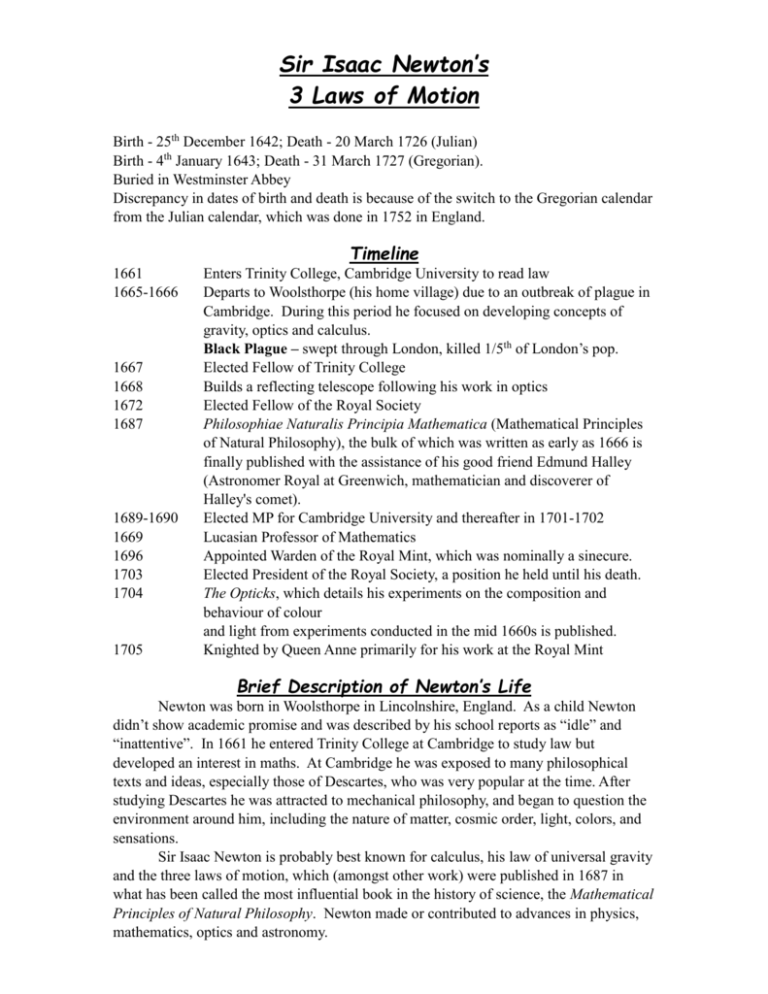
Sir Isaac Newton’s 3 Laws of Motion Birth - 25th December 1642; Death - 20 March 1726 (Julian) Birth - 4th January 1643; Death - 31 March 1727 (Gregorian). Buried in Westminster Abbey Discrepancy in dates of birth and death is because of the switch to the Gregorian calendar from the Julian calendar, which was done in 1752 in England. Timeline 1661 1665-1666 1667 1668 1672 1687 1689-1690 1669 1696 1703 1704 1705 Enters Trinity College, Cambridge University to read law Departs to Woolsthorpe (his home village) due to an outbreak of plague in Cambridge. During this period he focused on developing concepts of gravity, optics and calculus. Black Plague – swept through London, killed 1/5th of London’s pop. Elected Fellow of Trinity College Builds a reflecting telescope following his work in optics Elected Fellow of the Royal Society Philosophiae Naturalis Principia Mathematica (Mathematical Principles of Natural Philosophy), the bulk of which was written as early as 1666 is finally published with the assistance of his good friend Edmund Halley (Astronomer Royal at Greenwich, mathematician and discoverer of Halley's comet). Elected MP for Cambridge University and thereafter in 1701-1702 Lucasian Professor of Mathematics Appointed Warden of the Royal Mint, which was nominally a sinecure. Elected President of the Royal Society, a position he held until his death. The Opticks, which details his experiments on the composition and behaviour of colour and light from experiments conducted in the mid 1660s is published. Knighted by Queen Anne primarily for his work at the Royal Mint Brief Description of Newton’s Life Newton was born in Woolsthorpe in Lincolnshire, England. As a child Newton didn’t show academic promise and was described by his school reports as “idle” and “inattentive”. In 1661 he entered Trinity College at Cambridge to study law but developed an interest in maths. At Cambridge he was exposed to many philosophical texts and ideas, especially those of Descartes, who was very popular at the time. After studying Descartes he was attracted to mechanical philosophy, and began to question the environment around him, including the nature of matter, cosmic order, light, colors, and sensations. Sir Isaac Newton is probably best known for calculus, his law of universal gravity and the three laws of motion, which (amongst other work) were published in 1687 in what has been called the most influential book in the history of science, the Mathematical Principles of Natural Philosophy. Newton made or contributed to advances in physics, mathematics, optics and astronomy. Sir Isaac Newton’s 3 Laws of Motion Fun Fact – Newton was an alchemist, which means he believed that base metals could be magically transformed into gold (this was a popular belief at the time). First law (a restatement of Galileo's Law of Inertia) An object at rest will remain at rest and an object in motion will remain in motion in the same direction and speed unless an unbalanced force is applied to it. Objects resist changes in velocity, this is inertia. The more mass an object has the more inertia it will display. Until Newton, people used to believe that an object required force (what they called impetus) to continue moving. Experiment 1: Two objects on piece of paper. Without weighing or lifting them, how do you find out which one is heavier? Push each with the same force and see which one moves more, or pull the paper from underneath and see which one moved more. The one that moved more has less mass. Experiment 2: Can you use the law of inertia to explain why prey such as gazelles and antelope zigzag when chased by a predator such as a cheetah or lion? According to the law of inertia, should heavier prey such as zebra, wildebeest and buffalo zigzag? Second law (Law of acceleration) The acceleration of an object is in proportion to the force applied and is inversely proportion to the mass of the object. Or, Force = mass x acceleration (F=ma) E.g., to double the acceleration of an object, you can either double the force or decrease the mass by half. Experiment 1: Balloon with straw on thread. Pump balloon up to 10psi, see how far it travels. Double the psi and see if distance traveled is doubled. Hang weights on the balloon to increase mass. Third law (Law of interaction) Every action has an equal and opposite reaction. Balloon experiment also demonstrates this law. Exceptions to the laws Inapplicable to very small objects such as atoms, to objects at very high speeds (close to or equal to the speed of light), or to objects subjected to intense gravitational fields. Acceleration: increase or decrease of speed over time Force: is measured in Newtons (N) and is the force required to accelerate a 1kg mass at a rate of 1metre/second squared. A balanced force is two forces of equal magnitude acting in opposite directions. An unbalanced force has no force of equal magnitude acting on it from the opposite direction. Inertia: the resistance an object has to a change in its velocity. For example, heavier objects have greater inertia because the greater the mass of an object, the greater its resistance to change. Weight: Measure of the force gravity exerts on an object. An object's weight on the moon is about 1/6th of its weight on earth. Mass: Measure of the matter in an object.





